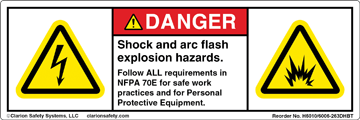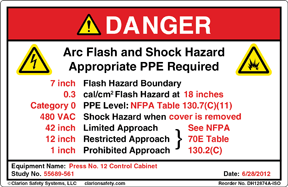In this column we’ll explore the kinds of safety markings designed to warn against electrical arc flash explosion hazards. In the United States, there are two primary documents engineers and facility owners use to determine their need to warn about arc flash hazards: the NFPA 70 National Electrical Code (NEC) and the NFPA 70E Standard for Electrical Safety in the Workplace.
The NEC first required arc flash safety labels in its 2002 edition and it referred to NFPA 70E for the actual label requirements. While the NFPA 70E standard requires that a label is provided to warn that an arc flash hazard exists, it does not specify exact label content. These two standards, in addition to OSHA’s requirement to warn about electrical hazards, create the need to label and warn against arc flash hazards.
The NEC leads to what, in practice, is a two-tier approach for arc flash labeling. First, electrical panel manufacturers place a general warning which communicates the presence of an arc flash hazard and that appropriate PPE is required in accordance with the NFPA 70E standard (Figure 1). This is the minimum labeling required to meet the code. The second label (Figure 2 on page 30) is more detailed and represents best practices in safety labeling for arc flash hazards. This label includes information from a specific panel in a specific location in a facility as defined by an arc flash study. It identifies the hazard severity, safe distances involved, and exact types of PPE required to avoid injury. It’s a good idea to use standardized formats for this second label, though the actual content elements need to be customized for each electrical panel in each facility.

Figure 1: A general arc flash safety label (courtesy of Clarion Safety Systems © 2012) typically applied by the manufacturer of the equipment.
Companies often utilize outside consultants to perform full arc flash studies so hazards are defined correctly. You don’t want to over-warn, such as requiring flame resistant clothing when it’s not necessary. At the same time, you don’t want to under-warn by mistakenly categorizing an arc flash hazard as less severe than it is. The labels that are the end result of an arc flash study are important elements in your facilities’ risk reduction/safety improvement plans, as they give employees and subcontractors the information they need to know to stay safe when performing electrical maintenance procedures.
NFPA 70E states that the design of arc flash labels should comply with the ANSI Z535.4 Standard for Product Safety Signs and Labels. This standard defines the use of signal words, colors, and formats. It also encourages the use of graphical symbols. This column is dedicated to helping engineers understand the markings that should go on their equipment. In this instance, as we’re talking about arc flash labeling, the addition of graphical symbols is to be recommended because they will help bring noticeability to the marking and they’ll help to communicate the message across language barriers.
When it comes to the exact symbol to be used on your arc flash labels, there is no graphic that has been standardized to specifically mean “arc flash explosion hazard.” Typically the ISO 7010 warning sign for “danger – electricity” is used (see the On Your Mark article in the November 2011 issue of In Compliance Magazine).

Figure 2: A specific arc flash safety label (courtesy of Clarion Safety Systems © 2012) as defined by an arc flash study typically applied by the equipment owner after an arc flash study.
At Clarion, we strive to create arc flash labels that comply with the latest versions of all four standards mentioned in this article: ANSI Z535, ISO 7010, NFPA 70E, and NEC (Figure 3). Combining the expertise in each standard to arrive at the proper content and format results in a label that represents today’s best practice methods for communicating safety and reducing risk.

Figure 3: Examples of standards-compliant, best practice arc flash safety labels (courtesy of Clarion Safety Systems © 2012) in use.
For more information about safety signs and symbols, visit www.clarionsafety.com. ![]()
 |
Geoffrey Peckham is president of Clarion Safety Systems and chair of both the ANSI Z535.2 Standard for Environmental and Facility Safety Signs and the U.S. Technical Advisory Group to ISO Technical Committee 145- Graphical Symbols. Over the past two decades he has played a pivotal role in the harmonization of U.S. and international safety standards dealing with safety signs, colors, formats and symbols. |
